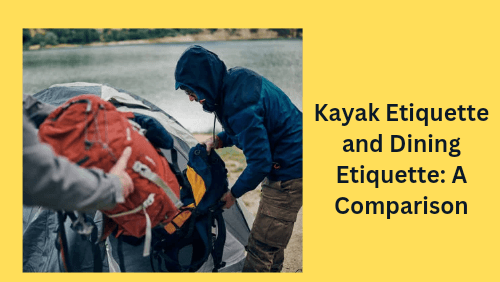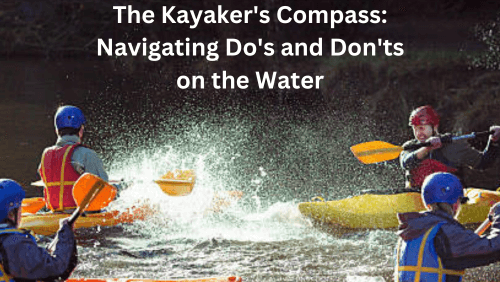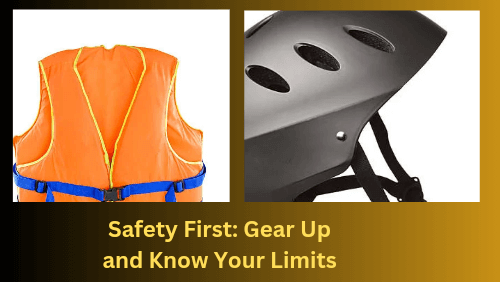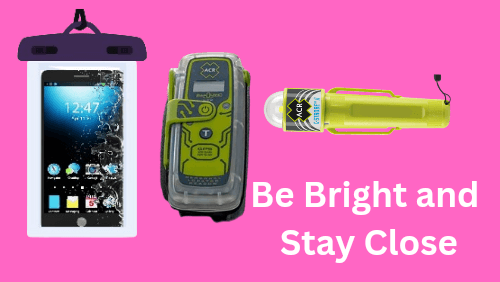My foray into the world of kayaking brought on a realization early on: the waters are more than a playground for paddlers; they’re a community space where manners matter as much as they do at a dinner table.
Kayak etiquette isn’t merely about paddling proficiency; it’s about navigating these shared spaces with attentiveness and courtesy.
Why Kayak Etiquette Matters

When I consider the importance of kayak etiquette, I see it like a buoy marking safe passage. It’s not just about avoiding collisions or being polite. It’s an essential framework that ensures everyone’s safety, keeps the environment clean, and fosters a sense of community among paddlers.
It serves as a code of conduct that transforms a potentially chaotic environment into a space where everyone, from the novice to the seasoned kayaker, can enjoy the water with an underlying assurance of mutual respect and care.
The Three Principles of Kayak Etiquette

What makes kayak etiquette crucial is its harmonious blend of the three principles of kayak etiquette.
- Respect
- Awareness
- Responsibility
Each of these principles is a paddle stroke that propels a kayaker towards a more enjoyable and secure experience.
And while it might seem intuitive to some, for others, it’s a learned skill that allows for the diverse community of paddlers to coexist peacefully on the water.
Kayak Etiquette and Dining Etiquette: A Comparison

Drawing parallels with dining etiquette might seem surprising at first glance. Yet, just like ignoring your table manners can ruin a meal for everyone, neglecting kayak etiquette can put yourself and others in harm’s way.
It’s about knowing when to yield, how to pass, and the way to offer help—actions that express regard for everyone’s right to a peaceful paddle.
Kayak Etiquette as a Sign of Bravery
In the spirit of sharing the water safely, I encourage all paddlers to reflect on their own waterway wisdom. As we transition to the next section, remember this:
the water is a meeting place for adventurers of all stripes, and adhering to etiquette not only displays character but underlines an unwavering commitment to bravery through respect.
The Kayaker’s Compass: Navigating Do’s and Don’ts on the Water

Your prowess as a paddler is more than just your ability to navigate the rapids or coast effortlessly on calm waters. It’s intimately linked to your understanding and application of kayaking etiquette—a compass that guides your interactions on the water.
What should be at the heart of every kayaker’s journey are the do’s and don’ts that shape our shared experiences.
Safety First: Gear Up and Know Your Limits

SAFETY GEAR IS NON-NEGOTIABLE.
A properly sized Personal Flotation Device (PFD) is as essential as the kayak itself. Remember, a lifejacket worn is a life saved. Similarly, a helmet is vital in rougher waters where head protection becomes critical. And let’s not forget the simple whistle—often the unsung hero in times of distress, cutting through the noise to signal for help.
Staying within the boundaries of your paddling capability is a mark of a seasoned kayaker. By choosing an environment that matches your expertise, you reduce the risk to yourself and others. Whether it’s the quiet backwater away from the bustle of motorboats or practicing re-entry techniques before heading out, always PADDLE WITHIN YOUR SKILL SET.
Be Prepared: Plan Ahead and Check Your Equipment
The obligations of a paddler extend far beyond personal preparation. As a vessel master of your craft, you shoulder the responsibility of safety for your vessel, which includes being compliant with regional marine laws and performing essential pre-departure checks. Lay the groundwork for a safe return by letting a trusted contact know your plans and return time.
Making sure your equipment meets legal safety standards and is in good working order cannot be understated. Lifejackets, for example, may have requirements that vary depending on how far you venture from the shoreline. The condition of your equipment is a critical factor—a well-maintained kayak and gear can make all the difference.
Respect the Water and the People: Don’t Be a Nuisance
Let’s not end on a negative, but a few things need to be made clear. DON’T LITTER. Respect for the natural world is a fundamental kayaking cornerstone. Also, avoid encroaching on private or sensitive areas; it’s more than basic manners—it’s about safety and respect for everyone’s rights. Avoid the impulse to be the impromptu instructor unless asked. Kayaking is a personal adventure, and unsolicited advice might not always be welcome. Lastly, remember to maintain composure on the water. Cursing the wind or shouting in frustration disrupts the peaceful sanctuary many seek in kayaking.
Visibility and Compliance: The Clear Path to Safe Paddling
You need to be seen to be safe. That’s the golden rule of visibility when you’re out on the water in a kayak.
Be Bright and Stay Close

In addition to carrying a waterproof communication device, bright clothing is just as important. Bright clothing isn’t just a fashion statement; it’s a beacon of safety. Sticking close to shore helps too. It’s simpler for other water-goers to spot you, and you’ll have a quicker escape route if things go south.
Light Up the Night

But it’s not just about being seen during the day. The twilight hours demand your respect too. Sticking a light on your kayak isn’t just a good idea; it’s a requirement when the sun starts to flirt with the horizon. You wouldn’t drive a car without headlights after dark, so you shouldn’t paddle without proper lighting either.
Follow the Rules of the Water

Now, let’s talk law – WA marine laws, to be exact. Any recreational vessel, powered or not, has rules to follow. For paddle craft, this means a nod to registration for those with motors, no matter how small the engine. Your paddle may not need a VIN, but if you slap on a motor, you’re stepping into a whole new world of regulations.
The WA regulations are in place for good reasons, safeguarding everyone who shares aquatic playgrounds. Lifejacket rules are particularly important, changing with the distance you are from the shore. Keep servicing those inflatable lifejackets too; they’re like parachutes – utterly useless if they don’t open when needed.
Plan Ahead and Check Your Gear
Before you leave the shore, tell someone where you’re going and when you plan to return. It’s a simple step, yet it’s as important as your paddle. Make those pre-departure checks religiously: weather, tide, gear – tick them off your list. And for those longer, epic quests away from shore, be even more rigorous.
If you’ve got a paddle leash, use it. It’s a lifeline for your paddle, and possibly for you. And stay on top of your gear maintenance; knowing your safety equipment expiry dates isn’t optional, it’s critical.
Know Your Playground
And lastly, before you push off from the familiar hugs of the shoreline, take time to get to know the space you’ll be calling your playground. It’s not just smart; it’s self-preservation.
Reflecting On Paddle Craft Etiquette
It all boils down to how we choose to navigate not just the waters, but also the shared experiences with fellow enthusiasts. The principles of kayak etiquette are essential to creating a safe and enjoyable environment for everyone involved. They go way beyond the basic need for safety and venture into the realm of personal character and the kayaking community’s spirit.
How Kayak Etiquette Shapes Our Stories

When I reflect on my own experiences on the water, it is clear that every action and decision contribute to a larger story. Each time I heed the tenets of kayak safety, dress appropriately for the conditions, and demonstrate respect for other paddlers and the natural environment, I reinforce the values of the kayaking world.
How Kayak Etiquette Reflects Our Integrity

Personal adherence to kayaking etiquette isn’t just about following a set of rules; it’s a measure of our integrity. It says much about who we are as paddlers and how we value the sport and its participants. We uphold a tradition that honors not only the sport’s heritage but also its future.
How Kayak Etiquette Inspires Our Commitment
I encourage every paddler to see the practice of kayak etiquette as a privilege and a responsibility. It is a commitment we make each time we set paddle to water, promising not only to take care of ourselves but also to safeguard the well-being of our community and the natural habitats we visit.
How Kayak Etiquette Enriches Our Experiences

As we finish this overview of kayak etiquette, I ask you to take these etiquettes to heart. Strive to embody them in every venture, and watch as they enrich your experiences on the water. Indeed, the journey of a great kayaker is never complete; it evolves with each stroke, with every shared adventure, and with the continuous respect we show for the waterways we treasure.
Join the Conversation
If you have thoughts to share, questions to ask, or experiences that highlight the importance of etiquette in paddling, I welcome you to join the conversation. Your insights are not only valuable; they help shape the rich tapestry of our paddling community.

